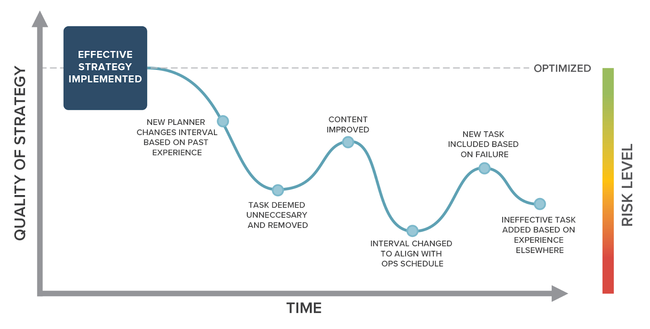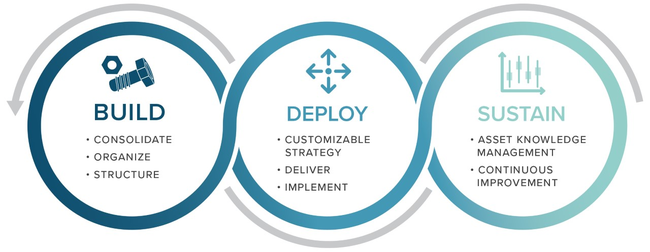
Integrated APM: An Introduction to the Asset Strategy Management (ASM) Pillar
The principles and tools of Reliability Centered Maintenance (RCM) have been around for decades, yet we still see many organizations struggling to effectively put these principles into practice and make reliability a reality.
Today's reliability managers understand the key elements of a sound reliability program—avoiding unexpected failures, outages, safety exposures and costs. They invest time and money into creating asset maintenance strategies but often fail to implement and execute the strategies effectively. There is no process for reliability strategy review and updates, or, even if there is, what's usually missing is any kind of trigger to start the review process.
The outcome of these typical environments is underperforming assets. This likely will have the associated problems of high-cost and unknown levels of risk. Ultimately the organization is not in control of the asset. There is no governance of the reliability strategy decision and related content.
There are two possibilities:
- Reliability strategy related content is being changed, informally, without overview, analysis, review, and approval.
- Reliability strategy related content is not changed at all because the process is so rigid.
Reliability strategy should be evolving constantly for a range of reasons such as:
- Operational context changing
- Changes in market conditions
- Equipment ages
- Technology changes
- Fixed cost changes
- Organizational priorities change
In environment one in Figure 1, the reliability strategy is changed informally. It is likely not changing at all in alignment with the changing environment. This leads to an unknown, potentially undesirable level of risk.
The environment in Figure 2 illustrates where reliability strategy rarely changes, mainly because of the difficulty, it certainly does not keep in alignment to the changing environment.
Because the quality of strategy deteriorates over time, the staggering reality is that most organizations do not know the level of risk with which they are operating based on their existing reliability strategies. In most cases the unplanned failures still being experienced are not unforeseeable, most could and should be addressed by a reliability strategy that is dynamic and always aligned to the changing operational environment.
Reliability strategies need constant refinement and adjustment to ensure they are always improving and delivering the optimal balance of risk, cost, and performance.
Asset Strategy Management (ASM) is a holistic, consistent and standardized approach to managing your asset strategies, organization wide. Physical assets and independent plants/sites are connected to a central system, allowing you to effectively develop, implement, maintain and optimize asset strategies.
Implementing an ASM program ensures that optimal strategies are always deployed, quickly and efficiently, resulting in the reduction of failures, downtime and risk, and consequently, a lower cost of operations.
Like work execution management, ASM is a business process that describes how the maintenance plans are managed over time so they continue to provide the desired balance of risk, cost, and asset performance.
The process identifies trigger points to engage, accountabilities for analysis, review and approval and requires a technical solution to support the process. ASM delivers performance improvement continually as data becomes available.
In short, Asset Strategy Management means that:
- The best strategies, developed by your best subject matter experts, are in place; and
- They are deployed to all your assets, all the time; and
- They continually evolve based on real data and an effective review process; and
- 他们可以很容易地更新,网站定制variations, and redeployed with ease
Tactical Plans:The maintenance plans that will be executed. Including the tasks to be performed, when they are done, how they are done, who does them, materials required.
Asset/Fleet:The decisions made at an asset level such as major component or asset replacement ages, major shutdown or system outage schedules.
Portfolio:Optimization of budget allocation for a portfolio to maximize value given the financial and resource constraints.
ASM can be simplified into three main phases. Breaking down the process into these core elements as shown in Figure 3 works for both initial implementation and ongoing ASM.
The first phase covers setting the structure for reliability strategy and developing baseline, optimal reliability strategies for each equipment type for a given asset criticality. Structured correctly, ASM offers a perfect platform for consolidating data and ensuring a single instance of each piece of reliability strategy content.
Once baseline reliability strategies have been created for each asset type they need to be deployed to the actual asset listing of hierarchy. There are four main components to the deploy phase:
- Use the baseline strategies and account for any different operating context and environmental conditions.
- Package the maintenance tasks into the agreed master data structure and implement into the EAM system.
- Gather feedback of master data keys
- Forecast the performance of the reliability strategies
Now that the reliability strategies have been deployed enterprise-wide, another key aspect of the ASM process is to sustain the integrity of the strategies. Governance of asset reliability strategies assure compliance and drives continuous improvement of the maintenance plans employed on all assets.
For reliability managers already busy putting out day-to-day fires, presents a number of challenges. Many of these challenges stem from their inability to leverage data - and specifically reliability content - across their organizations. This compounds the time it takes to build, deploy, and manage strategies and can result in ad hoc strategy development where changes are made without any structure, consistency, or justification.
Large, multisite organizations share a common challenge in that data is fragmented across many sources, restricting visibility into potential improvements and complicating things like the comparison of like assets and plans.
Specific data challenges include:
- A lack of, or inefficient data governance procedures to mandate the capture and recording of specific data
- Lack of guidelines and requirements that support consistent master data
- Inconsistent asset hierarchy driving different maintenance plan structures for like equipment
- Strategy development or review processes that are disconnected from the master data generation process and implementation
ASM can help rectify these challenges by providing a process and system that centralizes data.
It is not uncommon for organizations to have tens or hundreds of thousands of assets and a corresponding number of strategies. What organizations don't have is time or resources to regularly review and optimize those strategies, at least not in a traditional manner. With an always-on ASM process strategy review and optimization has never been more efficient.
Another challenge is that organizations lack a formal process to trigger or manage strategy reviews. So, there is no mechanism to kick start the strategy review and no way to identify which assets the reliability team should focus on. In these cases, a reactive maintenance culture can set in where people are more focused on fixing failures than trying to prevent them.
Reliability, particularly at a site level, often relies heavily on subject matter experts. However, what happens when those experts leave and take their knowledge with them?
With an ASM process and system in place to capture strategy-related content, when experts leave, important knowledge can be retained. This includes insight into past strategy-related decisions which can inform future improvements. It is also critical to maximize the available time from subject matter experts who are typically in demand. The right structure to asset review and data collection and refinement is key to ensure that the work is completed in an efficient but effective way.
Of course, capturing the knowledge of your best subject matter experts is not only important in case they leave; it can allow you to make that knowledge available for all to use. For example, if an optimal strategy is defined for an asset at one site, it can be leveraged across all others.
When RCM first began to hit its stride, organizations were quick to invest in the task of developing maintenance strategies. But, according to research[1], a massive 66 percent of corporate strategy is never implemented.
One of the issues here is that not all organizations have a line of sight into the field to know whether strategies are being implemented and, even if they are implemented, that's really just the first step.
The dynamic nature of the operating environment means that organizations need to frequently adjust their strategies to account for things like changes to performance targets. They also need good governance to ensure strategies are implemented in a consistent manner and not changed without a formal review.
To reap the benefits of reliability, you need the best strategies in place across all assets at all sites. However, this is next to impossible to achieve without a scalable process. Instead, organizations often end up with multiple strategies for the same asset type, even when those assets are performing the same duties under the same conditions.
Clearly only one (if any) of those strategies can be the optimal strategy, and much time is wasted by different sites designing different strategies for like assets.
The opportunity to rapidly make a change to an asset strategy, based on new information, is also lost when there are dissimilar strategies on like assets. This translates to lost opportunity, as any improvement initiative is deployed on only one asset, instead of the entire asset base.
For organizations using spreadsheets to manage asset strategies, it's common to have a different spreadsheet at each site. This limits the ability for organizations to leverage best practice across sites and makes it difficult for leaders to achieve a consolidated view of what's happening across the enterprise.
This lack of visibility ultimately impacts decision making and makes it difficult to prioritize resources to manage cost and risk.
It is the combination of the key design principles of the ASM process that provide value, both in terms of the productivity of the reliability and maintenance function and the ability to leverage key learnings and improvements across the entire organization.
With the ability to manage reliability strategy review, approval, and updated with digital workflows, plus digital reliability strategy content and rule-based maintenance task packaging and implementation, productivity gains to an organization are significant.
The concept of keeping reliability strategies aligned to the current operating environment becomes automatic, dynamic, and efficient. Most of all it leads to a true data-driven decision-making environment.
Digital connected reliability strategies, which form the foundation of the ASM process, ensure that you know the source of the routine tasks on each asset as it relates back to the corporate baseline reliability strategies. The variations are also recorded and easily visible at all times. This structure allows for any key learnings or improvements to be implemented locally and instantly assesses deployment to all other assets across the entire asset base to utilize the same baseline reliability strategy, while being mindful of local variations that have been made.
Practically speaking, this also translates to any improvement initiative, which is determined effective for implementation based on a review of a specific component. The improvement can be immediately assessed for all other instances of that component in the same area, the same site, or all sites within the same country or across an entire global asset base.
ASM provides a vehicle to deploy improvement initiatives and key reliability strategy developments across an entire asset base with a few clicks that, quite simply, isn't possible without it.
ASM removes inconsistencies from asset strategies to ensure your assets are running at their full potential, enterprise-wide. With ASM, you can easily align your maintenance strategies to operational and service level targets and deliver bottom-line results.
When maintenance strategies are changed without approval or maintenance intervals and tasks executed differ from your agreed strategy, you can be exposed to significant risk. ASM minimizes risk through workflow management, where unauthorized strategy changes (and risks) are eliminated.
ASM helps you achieve the optimal balance of performance, risk and cost. It significantly reduces spend on reactive maintenance, ensures assets are not over-maintained, and carries a lower risk with fewer accidents. It all leads to an overall reduction in maintenance spend, and a more assured way to manage your maintenance budget.
With an ASM process and component strategy library, maintenance strategies are built using generic templates and strategies are easily shared across like assets. It seamlessly integrates with an EAM system to ensure data accuracy and allows electronic deployment of asset strategies. Time is no longer spent with inefficient processes and duplicating work.
The maintenance strategies executed are one of the single biggest contributors to asset performance. ASM ensures that the best strategies are applied to all assets across all sites and provides data-driven intelligence to continually improve upon those strategies. The result is less time spent in reactive maintenance mode and more time delivering the highest value to the organization.
Pressure on time and resources was an ongoing challenge for a super-major oil and gas producer whose capital-project maintenance builds were costing too much and taking too long using a traditional maintenance-build approach. The company was experiencing continual overspending, missed deadlines, and maintenance strategies that didn't deliver the needed performance and reliability.
石油和天然气生产商选择武器的可靠性d its OnePM-powered ASM approach to complete their capital-project maintenance builds moving forward. ARMS Reliability provided a technical solution that halved the costs associated with maintenance builds and significantly simplified the process of completing them.
The ASM approach provided a single environment in which to complete maintenance builds, streamlining file management and eliminating the need for unstructured applications like Excel. Team members no longer had to deal with the inefficiencies, errors, and confusion that inevitably arose around sharing multiple files, versions, and file locations.
ASM also substantially reduced the number of contractors necessary to complete maintenance builds and created a full client-specific maintenance build library, leveraging their existing operations equipment-strategy library to offer operational context and to utilize their current best asset strategies.
After a successful pilot, the ASM solution OnePM was ultimately rolled out to the client's whole capital-projects portfolio of 5-10 major projects running simultaneously around the globe.
- 5-10x more efficient in building maintenance strategies
- Visibility of whole maintenance-build process and outputs in real-time
- Retention of maintenance-build intellectual property - easily comparing projects and regions
ASM ensures the asset care plan is always in alignment with current operating context, environment, asset age and condition. Along with the Asset Condition Monitoring (ACM), Asset Defect Elimination (ADE) and Enterprise Asset Management functions, ASM forms the foundation for world-class Asset Performance Management.
[1] Johnson, Lauren K. "Execute Your Strategy - Without Killing It."Harvard Management Update, No. 9, 2004: 3-6
Our Experts

Jason Apps
BIO
As CEO of ARMS Reliability, Jason oversees a global team focused on helping clients be safe and successful by making reliability a reality. Jason is the author of Asset Strategy Management ASMx: A Leader’s Guide to Reliability Transformation in the Digital Age.




